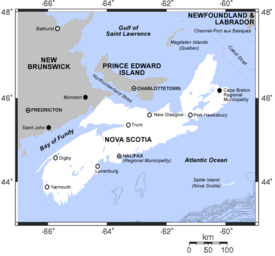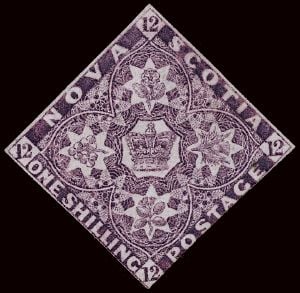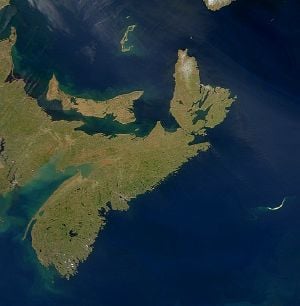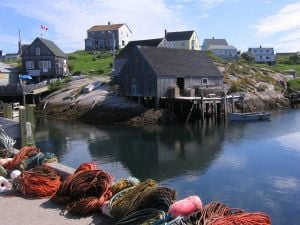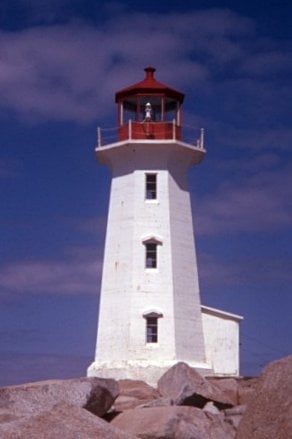Difference between revisions of "Nova Scotia" - New World Encyclopedia
Mary Anglin (talk | contribs) |
Mary Anglin (talk | contribs) |
||
| Line 118: | Line 118: | ||
==Economy== | ==Economy== | ||
| − | Nova Scotia's traditionally [[Natural resource|resource-based economy]] began diversifying in the latter decades of the twentieth century. The rise of Nova Scotia as a viable jurisdiction in [[North America]] was driven by the ready availability of natural resources, especially the [[fish]] stocks off the Scotian shelf. | + | Nova Scotia's traditionally [[Natural resource|resource-based economy]] began diversifying in the latter decades of the twentieth century. The rise of Nova Scotia as a viable jurisdiction in [[North America]] was driven by the ready availability of natural resources, especially the [[fish]] stocks off the Scotian shelf. The [[Fishing|fishery]] was a pillar of the economy since its development as part of the economy of [[New France]] in the 17th century. However, the fishery suffered a sharp decline due to [[overfishing]] in the late twentieth century. The collapse of the [[Atlantic Cod|cod stocks]] and the closure of this sector resulted in a loss of approximately 20,000 jobs in 1992. |
| + | Due, in part, to a strong [[small business]] sector, Nova Scotia now has one of the fastest growing economies in Canada. Small business makes up 92.2 percent of the provincial economy.<ref name = Migration> S. Carter. 2007-2008. [http://www.migrationnews.com/index.cfm/Canada/index.cfm/Canada/Migration_News___PDF_file.html/Migration_News___PDF_file.pdf Migrationnews Canada]. ''Oceania Development Group''. Retrieved November 14, 2008. </ref> [[Mining]], especially of [[gypsum]], [[salt]] and [[barite]], is also a significant sector. | ||
| + | Since 1991, [[Offshore drilling|offshore oil and gas]] has become an increasingly important part of the economy. [[Agriculture]] remains an important sector in the province. In the central part of Nova Scotia, [[Forestry|lumber and paper]] industries are responsible for many of the employment opportunities. Nova Scotia’s defense and aerospace sector generates approximately $500 million in revenues and contributes about $1.5 billion to the provincial economy annually.<ref> ''Nova Scotia Business Inc''. [http://www.novascotiabusiness.com/en/home/locate/sectorinfo/defense_aerospace.aspx Defence, Security & Aerospace].Retrieved November 14, 2008.</ref> Nova Scotia has the 4th largest [[film industry]] in Canada hosting over 100 productions yearly, more than half of which are the products of international film and television producers.<ref> ''Nova Scotia Film Development Corporation''. [http://www.film.ns.ca/pdfs/2007-08%20stat%20summary%20for%20Press%20release.pdf Production Statistics for the 12 Month Period Ended March 31, 2008]. Retrieved November 14, 2008.</ref> | ||
| − | + | The Nova Scotia [[tourism]] industry includes more than 6,500 direct businesses, supporting nearly 40,000 jobs. Two hundred thousand [[cruise ship]] passengers from around the world flow through the [[Port of Halifax]] each year.<ref> ''Government of Nova Scotia''. [http://www.gov.ns.ca/econ/exportstrategy/docs/Export_Development_Strategy-NS.pdf Going Global, | |
| − | + | Staying Local: A Partnership Strategy for Export Development]. Retrieved November 14, 2008.</ref> Halifax ranks among the top five most cost-effective places to do business when compared to large international centers in North America, Europe and Asia-Pacific.<ref name = Migration/> | |
| − | |||
| − | |||
| − | |||
| − | |||
| − | |||
| − | The Nova Scotia [[tourism]] industry includes more than 6,500 direct businesses, supporting nearly 40,000 jobs. | ||
| − | Staying Local: A Partnership Strategy for Export Development]. Retrieved | ||
| − | |||
| − | |||
==Education== | ==Education== | ||
Revision as of 00:42, 14 November 2008
| |||||
| Motto: Munit Hae et Altera Vincit (Latin: One defends and the other conquers) | |||||
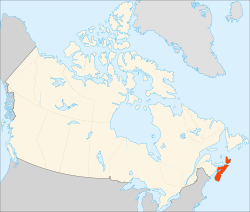
| |||||
| Capital | Halifax | ||||
|---|---|---|---|---|---|
| Largest city | Halifax | ||||
| Official languages | English | ||||
| Government | |||||
| - Lieutenant-Governor | Mayann E. Francis | ||||
| - Premier | Rodney McDonald (PC) | ||||
| Federal representation | in Canadian Parliament | ||||
| - House seats | 11 | ||||
| - Senate seats | 10 | ||||
| Confederation | July 1, 1867 (1st) | ||||
| Area | Ranked 12th | ||||
| - Total | 55,283 km² (21,345 sq mi) | ||||
| - Land | 53,338 km² (20,594 sq mi) | ||||
| - Water (%) | 1,946 km² (751 sq mi) (3.5%) | ||||
| Population | Ranked 7th | ||||
| - Total (2008) | 935,962 (est.)[1] | ||||
| - Density | 17.49/km² (45.3/sq mi) | ||||
| GDP | Ranked 7th | ||||
| - Total (2006) | C$31.966 billion[2] | ||||
| - Per capita | C$34,210 (11th) | ||||
| Abbreviations | |||||
| - Postal | NS | ||||
| - ISO 3166-2 | CA-NS | ||||
| Time zone | UTC-4 | ||||
| Postal code prefix | B | ||||
| Flower | Mayflower | ||||
| Tree | Red Spruce | ||||
| Bird | Osprey | ||||
| Web site | www.gov.ns.ca | ||||
| Rankings include all provinces and territories | |||||
Nova Scotia (IPA: /ˌnəʊvəˈskəʊʃə/) (Latin for New Scotland; Scottish Gaelic: Alba Nuadh; French: Nouvelle-Écosse) is a Canadian province located on Canada's southeastern coast. It is the most populous province in Atlantic Canada. Its capital, Halifax, is a major economic centre of the region. Nova Scotia is the second smallest province in Canada with an area of 55,284 km². Its population of 935,962[3] makes it the fourth least populous province of the country, though second most densely populated.
Nova Scotia's economy is traditionally largely resource-based, but has diversified since the middle of the 20th century. Industries such as fishing, mining, forestry and agriculture remain very important and have been joined by tourism, technology, film, music, and finance.
The province includes several regions of the Mi'kmaq nation of Mi'gma'gi, which covered all of the Maritimes, as well as parts of Maine, Newfoundland and the Gaspé Peninsula. Nova Scotia was already home to the Mi'kmaq people when the first European colonists arrived. In 1604, French colonists established the first permanent European settlement north of Florida at Port Royal, founding what would become known as Acadia. The British Empire obtained control of the region between 1713 and 1760, and established a new capital at Halifax in 1749. In 1867 Nova Scotia was one of the founding provinces of the Canadian Confederation, along with New Brunswick, and the Province of Canada (which became the separate provinces of Quebec and Ontario).
Geography
Nova Scotia is a province located in eastern Canada fronting the Atlantic Ocean to the south and east, the Gulf of Saint Lawrence to the north, and the Bay of Fundy to the west. One of the Maritime Provinces, its geography is complex, despite its relatively small size in comparison to other Canadian provinces in the central and western portions of the country.
The province's mainland is the Nova Scotia peninsula surrounded by the Atlantic Ocean, including numerous bays and estuaries. There is no location within Nova Scotia that is more than 67 km (40 mi) from a body of water. Cape Breton Island, a large island to the northeast of the Nova Scotia mainland, is also part of the province, as is Sable Island, a small island notorious for its shipwrecks, approximately 175 km (109 mi) from the province's southern coast.
Nova Scotia is Canada's second smallest province in area after Prince Edward Island. It does not stretch as far north as any other province, making it Canada's most southern province even though it does not have the most southern location in Canada. Both Ontario and Quebec stretch farther south than does Nova Scotia.
Climate
Nova Scotia lies in the mid temperate zone and, although the province is almost completely surrounded by water, the climate is closer to continental rather than maritime. The temperature extremes of the continental climate are moderated by the ocean.
Rainfall varies from 140 centimeters (55 in) in the south to 100 centimeters (40 in) elsewhere. It is very foggy in places, with Halifax averaging 196 foggy days per year and Yarmouth 191.
Due to the ocean's moderating effect, Nova Scotia is the warmest of the Canadian provinces. It has a fairly wide but not extreme temperature range, a late and long summer, skies that are often cloudy or overcast; frequent coastal fog and marked changeability of weather from day to day. The main factors influencing Nova Scotia's climate are:
- The effects of the westerly winds
- The interaction between three main air masses which converge on the east coast
- Nova Scotia's location on the routes of the major eastward-moving storms
- The modifying influence of the sea.
Because Nova Scotia juts into the Atlantic, it is prone to tropical storms and hurricanes in the summer and autumn. There have been 33 such storms, including 12 hurricanes, since records were kept in 1871—about once every four years.
History
Paleo-Indians camped at locations in present-day Nova Scotia approximately 11,000 years ago. Archaic Indians are believed to have been present in the area between 1,000 and 5,000 years ago. Mi'kmaq, the First Nations of the province and region, are their direct descendants.
Some believe that the Vikings may have settled in Nova Scotia at some time, though there is little evidence of this, and the claim is disputed by historians. The only authenticated Viking settlement in North America is L'Anse aux Meadows, which establishes the fact that Vikings explored the continent 500 years before Christopher Columbus.
While there is some debate over where he landed, it is most widely believed that the Italian explorer John Cabot visited present-day Cape Breton in 1497.[2] The first European settlement in Nova Scotia was established more than a century later in 1604. The French, led by Pierre Dugua, Sieur de Monts established the first capital for the colony Acadia at Port Royal that year at the head of the Annapolis Basin. Also, French fishermen established a settlement at Canso the same year.
In 1620, the Plymouth Council for New England, under King James I (of England) & VI (of Scots) designated the whole shorelines of Acadia and the Mid-Atlantic colonies south to the Chesapeake Bay as New England. The first documented Scottish settlement in the Americas was of Nova Scotia in 1621. On 29 September 1621, the charter for the foundation of a colony was granted by James VI to William Alexander, 1st Earl of Stirling and, in 1622, the first settlers left Scotland. This settlement initially failed because of difficulties in obtaining a sufficient number of skilled emigrants, and in 1624 James VI created a new order of baronets. Admission to this order was obtained by sending six labourers or artisans, sufficiently armed, dressed and supplied for two years, to Nova Scotia, or by paying 3,000 merks to William Alexander. For six months, no one took up this offer until James compelled one to make the first move.
In 1627, there was a wider uptake of baronetcies and thus more settlers available to go to Nova Scotia. However, in 1627, war broke out between England and France, and the French re-established a settlement at Port Royal which they had originally settled. Later that year, a combined Scottish and English force destroyed the French settlement, forcing them out. In 1629, the first Scottish settlement at Port Royal was inhabited. The colony's charter, in law, made Nova Scotia (defined as all land between Newfoundland and New England) a part of mainland Scotland, this was later used to get around the English navigation acts. However, this did not last long: in 1631, under King Charles I, the Treaty of Suza was signed which returned Nova Scotia to the French. The Scots were forced by Charles to abandon their mission before their colony had been properly established, and the French assumed control of the Mi'kmaq and other First Nations territory.
In 1654, King Louis XIV of France appointed aristocrat Nicholas Denys as Governor of Acadia and granted him the confiscated lands and the right to all its minerals. English colonists captured Acadia in the course of King William's War, but England returned the territory to France in the Treaty of Ryswick at the end of the war. The territory was recaptured by forces loyal to Britain during the course of Queen Anne's War, and its conquest was confirmed by the Treaty of Utrecht of 1713. France retained possession of Île St Jean (Prince Edward Island) and Île Royale (Cape Breton Island), on which it established a fortress at Louisbourg to guard the sea approaches to Quebec. This fortress was captured by American colonial forces, then returned by the British to France, then ceded again after the French and Indian War of 1755.
Thus mainland Nova Scotia became a British colony in 1713, although Samuel Vetch had a precarious hold on the territory as governor from the fall of Acadian Port-Royal (Annapolis Royal) in October 1710. British governing officials became increasingly concerned over the unwillingness of the French-speaking, Roman Catholic Acadians, who were the majority of colonists, to pledge allegiance to the British Crown, then George II. The colony remained mostly Acadian despite the establishment of Halifax as the province's capital, and the settlement of a large number of foreign Protestants (some French and Swiss but mostly German) at Lunenburg in 1753. In 1755, the British forcibly expelled over 12,000 Acadians in what became known as the Grand Dérangement, or Great Expulsion.
At the same time the British Crown began bestowing land grants in Nova Scotia on favored subjects to encourage settlement and trade with the mother country. In June 1764, for instance, the Boards of Trade requested the King make massive land grants to such Royal favorites as Thomas Pownall, Richard Oswald, Humphry Bradstreet, John Wentworth, Thomas Thoroton[4] and Lincoln's Inn barrister Levett Blackborne.[5] Two years later, in 1766, at a gathering at the home of Levett Blackborne, an adviser to the Duke of Rutland, Oswald and his friend James Grant were released from their Nova Scotia properties so they could concentrate on their grants in British East Florida.[6]
The colony's jurisdiction changed during this time. Nova Scotia was granted a supreme court in 1754 with the appointment of Jonathan Belcher and a Legislative Assembly in 1758. In 1763 Cape Breton Island became part of Nova Scotia. In 1769, St. John's Island (now Prince Edward Island) became a separate colony. The county of Sunbury was created in 1765, and included all of the territory of current day New Brunswick and eastern Maine as far as the Penobscot River. In 1784 the western, mainland portion of the colony was separated and became the province of New Brunswick, and the territory in Maine entered the control of the newly independent American state of Massachusetts. Cape Breton became a separate colony in 1784 only to be returned to Nova Scotia in 1820.
Ancestors of more than half of present-day Nova Scotians arrived in the period following the Acadian Expulsion. Between 1759 and 1768, about 8,000 New England Planters responded to Governor Charles Lawrence's request for settlers from the New England colonies. Several years later, approximately 30,000 United Empire Loyalists (American Tories) settled in Nova Scotia (when it comprised present-day Maritime Canada) following the defeat of the British in the American Revolutionary War. Of these 30,000, 14,000 went to New Brunswick and 16,000 went to Nova Scotia. Approximately 3,000 of this group were Black Loyalists, about a third of whom soon relocated themselves to Sierra Leone in 1792 via the Committee for the Relief of the Black Poor, becoming the Original settlers of Freetown. Large numbers of Gaelic-speaking Highland Scots emigrated to Cape Breton and the western part of the mainland during the late 18th century and 19th century. About one thousand Ulster Scots settled in mainly central Nova Scotia during this time, as did just over a thousand farming migrants from Yorkshire and Northumberland between 1772 and 1775.
Nova Scotia was the first colony in British North America and in the British Empire to achieve responsible government in January-February 1848 and become self-governing through the efforts of Joseph Howe. Pro-Confederate premier Charles Tupper led Nova Scotia into the Canadian Confederation in 1867, along with New Brunswick and the Province of Canada.
In the provincial election of 1868, the Anti-Confederation Party won 18 out of 19 federal seats, and 36 out of 38 seats in the provincial legislature. For seven years, William Annand and Joseph Howe led the ultimately unsuccessful fight to convince British imperial authorities to release Nova Scotia from Confederation. The government was vocally against Confederation, contending that it was no more than the annexation of the province to the pre-existing province of Canada:
"...the scheme [confederation with Canada] by them assented to would, if adopted, deprive the people [of Nova Scotia] of the inestimable privilege of self-government, and of their rights, liberty, and independence, rob them of their revenue, take from them the regulation of trade and taxation, expose them to arbitrary taxation by a legislature over which they have no control, and in which they would possess but a nominal and entirely ineffective representation; deprive them of their invaluable fisheries, railroads, and other property, and reduce this hitherto free, happy, and self-governed province to a degraded condition of a servile dependency of Canada."
from Address to the Crown by the Government (Journal of the House of Assembly, Province of Nova Scotia, 1868)
A motion passed by the Nova Scotia House of Assembly in 1868 refusing to recognise the legitimacy of Confederation has never been rescinded. Repeal, as anti-confederation became known, would rear its head again in the 1880s, and transform into the Maritime Rights Movement in the 1920s. Some Nova Scotia flags flew at half mast on Dominion Day as late as that time.
Government and politics
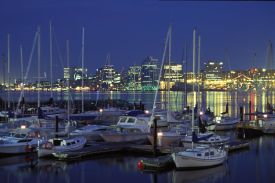
The government of Nova Scotia is a parliamentary democracy. Its unicameral legislature, the Nova Scotia House of Assembly, consists of fifty-two members. As Canada's head of state, Queen Elizabeth II is the head of Nova Scotia's Executive Council, which serves as the Cabinet of the provincial government. Her Majesty's duties in Nova Scotia are carried out by her representative, the Lieutenant-Governor. Halifax is home to the House of Assembly and Lieutenant-Governor.
Nova Scotia's politics are divided on regional lines in such a way that it has become difficult to elect a majority government. Rural mainland Nova Scotia has largely been aligned behind the Progressive Conservative Party, Halifax Regional Municipality has overwhelmingly supported the New Democrats, with Cape Breton voting for Liberals with a few Progressive Conservatives and New Democrats. This has resulted in a three-way split of votes on a province-wide basis for each party and difficulty in any party gaining a majority.
In 1996 the incorporated cities within the province were amalgamated into Regional Municipalities. Halifax, the provincial capital, is now part of the Halifax Regional Municipality, as is Dartmouth, formerly the province's second largest city. The former city of Sydney is now part of the Cape Breton Regional Municipality.
Economy
Nova Scotia's traditionally resource-based economy began diversifying in the latter decades of the twentieth century. The rise of Nova Scotia as a viable jurisdiction in North America was driven by the ready availability of natural resources, especially the fish stocks off the Scotian shelf. The fishery was a pillar of the economy since its development as part of the economy of New France in the 17th century. However, the fishery suffered a sharp decline due to overfishing in the late twentieth century. The collapse of the cod stocks and the closure of this sector resulted in a loss of approximately 20,000 jobs in 1992.
Due, in part, to a strong small business sector, Nova Scotia now has one of the fastest growing economies in Canada. Small business makes up 92.2 percent of the provincial economy.[7] Mining, especially of gypsum, salt and barite, is also a significant sector.
Since 1991, offshore oil and gas has become an increasingly important part of the economy. Agriculture remains an important sector in the province. In the central part of Nova Scotia, lumber and paper industries are responsible for many of the employment opportunities. Nova Scotia’s defense and aerospace sector generates approximately $500 million in revenues and contributes about $1.5 billion to the provincial economy annually.[8] Nova Scotia has the 4th largest film industry in Canada hosting over 100 productions yearly, more than half of which are the products of international film and television producers.[9]
The Nova Scotia tourism industry includes more than 6,500 direct businesses, supporting nearly 40,000 jobs. Two hundred thousand cruise ship passengers from around the world flow through the Port of Halifax each year.[10] Halifax ranks among the top five most cost-effective places to do business when compared to large international centers in North America, Europe and Asia-Pacific.[7]
Education
The Minister of Education is responsible for the administration and delivery of education, as defined by the Education Act[11] and other acts relating to colleges, universities and private schools. The powers of the Minister and the Department of Education are defined by the Ministerial regulations and constrained by the Governor-In-Council regulations.
Nova Scotia has more than 450 public schools for children. The public system offers primary to Grade 12. There are also some private schools in the province. Public education is administered by seven regional school boards, responsible primarily for English instruction and French immersion, and also province wide by the Conseil Scolaire Acadien Provincial, which administer French instruction to students for whom the primary language is French.
The Nova Scotia Community College system has 13 campuses around the province. The community college, with its focus on training and education, was established in 1988 by amalgamating the province's former vocational schools.
The province has 12 universities and colleges, including Dalhousie University, University of King's College, Saint Mary's University (Halifax), Mount Saint Vincent University, Nova Scotia College of Art and Design, Acadia University, Université Sainte-Anne, Saint Francis Xavier University, Nova Scotia Agricultural College, Cape Breton University, and the Atlantic School of Theology.
Demographics
According to the 2001 Canadian census[12] the largest ethnic group in Nova Scotia is Scottish (29.3%), followed by English (28.1%), Irish (19.9%), French (16.7%), German (10.0%), Dutch (3.9%), First Nations (3.2%), Welsh (1.4%), Italian (1.3%), and Acadian (1.2%). Almost half of all respondents (47.4%) identified their ethnicity as "Canadian."
Top Ten Counties by Population
| County | 2001 | 2006 |
| Halifax (county) | 359,183 | 372,858 |
|---|---|---|
| Cape Breton (county) | 109,330 | 105,928 |
| Kings County | 58,866 | 60,035 |
| Colchester County | 49,307 | 50,023 |
| Lunenburg County | 47,591 | 47,150 |
| Pictou County | 46,965 | 46,513 |
| Hants County | 40,513 | 41,182 |
| Cumberland County | 32,605 | 32,046 |
| Yarmouth County | 26,843 | 26,277 |
| Annapolis County | 21,773 | 21,438 |
| Shelburne County | N/A | 16,231 |
Language
The 2006 Canadian census showed a population of 913,462.
Of the 899,270 singular responses to the census question concerning 'mother tongue' the most commonly reported languages were:
| Rank | Language | Respondants | Percentage |
|---|---|---|---|
| 1. | English | 832,105 | 92.53% |
| 2. | French | 32,540 | 3.62% |
| 3. | Arabic | 4,425 | 0.49% |
| 4. | Mi'kmaq | 4,060 | 0.45% |
| 5. | German | 4,045 | 0.45% |
| 6. | Chinese | 3,370 | 0.37% |
| 7. | Dutch | 2,440 | 0.27% |
| 8. | Polish | 1,570 | 0.17% |
| 9. | Spanish | 1,305 | 0.15% |
| 10. | Greek | 1,035 | 0.12% |
| 11. | Italian | 905 | 0.10% |
| 12. | Korean | 860 | 0.10% |
| 13. | Gaelic | 799 | 0.10% |
In addition, there were also 105 responses of both English and a 'non-official language'; 25 of both French and a 'non-official language'; 495 of both English and French; 10 of English, French, and a 'non-official language'; and about 10,300 people who either did not respond to the question, or reported multiple non-official languages, or else gave some other unenumerated response. Figures shown are for the number of single language responses and the percentage of total single-language responses.[13]
Religion
The largest denominations by number of adherents according to the 2001 census were the Roman Catholic Church with 327,940 (37 %); the United Church of Canada with 142,520 (16 %); and the Anglican Church of Canada with 120,315 (13 %).[14]
Culture
Despite the small population of the province, Nova Scotia's music and culture is influenced by several well established cultural groups, that are sometimes referred to as the "founding cultures".
Originally populated by the Mi'kmaq First Nation, the first European settlers were the French, who founded Acadia in 1604. Nova Scotia was briefly colonized by Scottish settlers in 1620, though by 1624 the Scottish settlers had been removed by treaty and the area was turned over to the French until the mid-18th century. After the defeat of the French and prior expulsion of the Acadians, settlers of English, Irish, Scottish and African descent began arriving on the shores of Nova Scotia.
Settlement was greatly accelerated by the resettlement of Loyalists in Nova Scotia during the period following the end of the American Revolutionary War. It was during this time that a large African Nova Scotian community took root, populated by freed slaves and Loyalist blacks and their families, who had fought for the crown in exchange for land. This community later grew when the Royal Navy began intercepting slave ships destined for the United States, and deposited these free slaves on the shores of Nova Scotia.
Later, in the 19th century the Irish Famine and, especially, the Scottish Highland Clearances resulted in large influxes of migrants with Celtic cultural roots, which helped to define the dominantly Celtic character of Cape Breton and the north mainland of the province. This Gaelic influence continues to play an important role in defining the cultural life of the province and around 500 - 2000 Nova Scotians today are fluent in Scottish Gaelic. Nearly all live in Antigonish County or on Cape Breton Island.[15][16]
Modern Nova Scotia is a mix of many cultures. The government works to support Mi'kmaq, French, Gaelic and African-Nova Scotian culture through the establishment of government secretariats, as well as colleges, educational programs and cultural centres. The Province is also eager to attract new immigrants,[17] but has had limited success. The major population centres at Halifax and Sydney are the most cosmopolitan, hosting large Arab populations (in the former) and Eastern European populations (in the latter). Halifax Regional Municipality hosts a yearly multicultural festival.[18]
Arts
Nova Scotia has long been a centre for artistic and cultural excellence. Halifax has emerged as the leading cultural centre in the Atlantic region. The city hosts such institutions such as NSCAD University, one of Canada's leading art, craft and design colleges, and the Symphony Nova Scotia, the only full orchestra performing in Atlantic Canada. The province is home to avant-garde visual art and traditional crafting, writing and publishing, and a film industry.
Nova Scotia is arguably best known for its music. While popular music from many genres has experienced almost two decades of explosive growth and success in Nova Scotia, the province remains best known for its folk and traditional based music. Nova Scotia's traditional (or folk) music is Scottish in character, and traditions from Scotland are kept true to form, in some cases more so than in Scotland. This is especially true of the island of Cape Breton, one of the major international centres for Celtic music.
On main land Nova Scotia, particularly in some of the rural villages throughout Guysborough County, Irish influenced styles of music are commonly played, due to the predominance of Irish culture in many of the county's villages.
Bibliography
Surveys
- Beck, J. Murray. The Government of Nova Scotia University of Toronto Press, 1957, the standard history
- Choyce, Lesley. Nova Scotia: Shaped by the Sea. A Living History. Toronto: Penguin Books Canada, 1996. 305 pp.
- Donovan, Kenneth, ed. Cape Breton at 200: Historical Essays in Honour of the Island's Bicentennial, 1785-1985. Sydney, N.S.: U. Coll. of Cape Breton Pr., 1985. 261 pp.
- Fingard, Judith; Guildford, Janet; and Sutherland, David. Halifax: The First 250 Years Halifax: Formac, 1999. 192 pp.
- Girard, Philip; Phillips, Jim; and Cahill, Barry, ed. The Supreme Court of Nova Scotia, 1754-2004: From Imperial Bastion to Provincial Oracle U. of Toronto Press 2004.
- Johnson, Ralph S. Forests of Nova Scotia: A History. Tantallon: Nova Scotia Dept. of Lands and Forests; Four East Publ., 1986. 407 pp.
- Loomer, L. S. Windsor, Nova Scotia: A Journey in History. Windsor, N.S.: West Hants Hist. Soc., 1996. 399 pp.
- Robertson, Allen B. Tide & Timber: Hantsport, Nova Scotia, 1795-1995. Hantsport, N.S.: Lancelot, 1996. 182 pp.
- Robertson, Barbara R. Sawpower: Making Lumber in the Sawmills of Nova Scotia. Halifax: Nimbus; Nova Scotia Mus., 1986. 244 pp.
Since 1900
- Beck, J. Murray. Politics of Nova Scotia. vol 2: 1896-1988. Tantallon, N.S.: Four East 1985 438 pp.
- Bickerton, James P. Nova Scotia, Ottawa and the Politics of Regional Development. U. of Toronto Press 1990. 412 pp.
- Creighton, Wilfred. Forestkeeping: A History of the Department of Lands and Forests in Nova Scotia, 1926-1969. Halifax: Nova Scotia Dept. of Lands and Forests, 1988. 155 pp.
- Earle, Michael, ed. Workers and the State in Twentieth Century Nova Scotia. Fredericton: Acadiensis, 1989.
- Frank, David. J. B. McLachlan: A Biography - the Story of a Legendary Labour Leader and the Cape Breton Coal Miners. Toronto: Lorimer, 1999. 592 pp.
- Fraser, Dawn. Echoes from Labor's Wars: The Expanded Edition, Industrial Cape Breton in the 1920's, Echoes of World War One, Autobiography and Other Writings. Wreck Cove, N.S.: Breton Books, 1992. 177 pp.
- McKay, Ian. The Quest of the Folk: Antimodernism and Cultural Selection in Twentieth-Century Nova Scotia. McGill-Queen's U. Pr., 1994. 371 pp.
- McKay, Ian. The Craft Transformed: An Essay on the Carpenters of Halifax, 1885-1985. Halifax, N.S.: Holdfast, 1985. 148 pp.
- March, William DesB. Red Line: The Chronicle-Herald and Mail-Star, 1875-1954. Halifax, N.S.: Chebucto Agencies, 1986. 415 pp.
- Morton, Suzanne. Ideal Surroundings: Domestic Life in a Working-Class Suburb in the 1920s. U. of Toronto Pr., 1995. 201 pp. about Richmond Heights
- Sandberg, L. Anders and Clancy, Peter. Against the Grain: Foresters and Politics in Nova Scotia. U. of British Columbia Pr., 2000. 352 pp.
- Sandberg, L. Anders, ed. Trouble in the Woods: Forest Policy and Social Conflict in Nova Scotia and New Brunswick. Fredericton, N.B.: Acadiensis, 1992. 234 pp.
Notes
- ↑ Statistics Canada. Canada's population estimates 2008-06-25. Retrieved 2008-06-25.
- ↑ Gross domestic product, expenditure-based, by province and territory
- ↑ Statistics Canada. Canada's population estimates 2008-06-25. Retrieved 2008-06-25.
- ↑ Thomas Blackborne Thoroton was married to an illegitimate daughter of the Duke of Rutland. He and other family members, including Thoroton's half-brother barrister Levett Blackborne, had close business and social relationships with Richard Oswald and James Grant, who were instrumental in the English colonies in East Florida and Nova Scotia.[1]
- ↑ Representation to His Majesty with a List of Several persons for Grants of Lands in Nova Scotia, Representations of the Lords of Trade to the King, June 5, 1764, www.heritage.nf.ca
- ↑ The Florida Historical Quarterly, vol. LIV, No. 4, April 1976, Gainesville, FL
- ↑ 7.0 7.1 S. Carter. 2007-2008. Migrationnews Canada. Oceania Development Group. Retrieved November 14, 2008.
- ↑ Nova Scotia Business Inc. Defence, Security & Aerospace.Retrieved November 14, 2008.
- ↑ Nova Scotia Film Development Corporation. Production Statistics for the 12 Month Period Ended March 31, 2008. Retrieved November 14, 2008.
- ↑ Government of Nova Scotia. [http://www.gov.ns.ca/econ/exportstrategy/docs/Export_Development_Strategy-NS.pdf Going Global, Staying Local: A Partnership Strategy for Export Development]. Retrieved November 14, 2008.
- ↑ Government of Nova Scotia (1996). Education Act. Retrieved 2007-04-26.
- ↑ Statistics Canada (2005). Population by selected ethnic origins, by province and territory (Census 2001). Retrieved 2007-04-26.
- ↑ Detailed Mother Tongue (186), Knowledge of Official Languages (5), Age Groups (17A) and Sex (3) (2006 Census)
- ↑ http://www12.statcan.ca/english/census01/products/highlight/Religion/Page.cfm?Lang=E&Geo=PR&View=1a&Code=12&Table=1&StartRec=1&Sort=2&B1=12&B2=All
- ↑ Nova Scotia Archives. Gaelic Resources. Retrieved 2007-04-26.
- ↑ Office of Gaelic Affairs
- ↑ Nova Scotia Office of Immigration. Nova Scotia. Retrieved 2007-04-26.
- ↑ Nova Scotia Multicultural Festival (2007). Retrieved 2007-04-26.
ReferencesISBN links support NWE through referral fees
- DESSERUD, D. A. 1999. "An Outpost's Response: The Language and Politics of Moderation in Eighteenth-Century Nova Scotia". AMERICAN REVIEW OF CANADIAN STUDIES. 29: 379-406.
- Mancke, Elizabeth. 2005. The fault lines of empire: political differentiation in Massachusetts and Nova Scotia, ca. 1760-1830. New World in the Atlantic world. New York, NY: Routledge. ISBN 0415950007 and ISBN 9780415950008 Online version. Retrieved May 9, 2008.
- Whitelaw, William Menzies. 1934. The Maritimes and Canada before Confederation. Toronto: Oxford University Press. Online version. Retrieved May 9, 2008.
External links
All links Retrieved May 10, 2008.
- The Climate of Nova Scotia
- Nova Scotia Monuments
- Panoramic Photos of Nova Scotia
- Little-Known Portions of Nova Scotia History
Credits
New World Encyclopedia writers and editors rewrote and completed the Wikipedia article in accordance with New World Encyclopedia standards. This article abides by terms of the Creative Commons CC-by-sa 3.0 License (CC-by-sa), which may be used and disseminated with proper attribution. Credit is due under the terms of this license that can reference both the New World Encyclopedia contributors and the selfless volunteer contributors of the Wikimedia Foundation. To cite this article click here for a list of acceptable citing formats.The history of earlier contributions by wikipedians is accessible to researchers here:
The history of this article since it was imported to New World Encyclopedia:
Note: Some restrictions may apply to use of individual images which are separately licensed.


